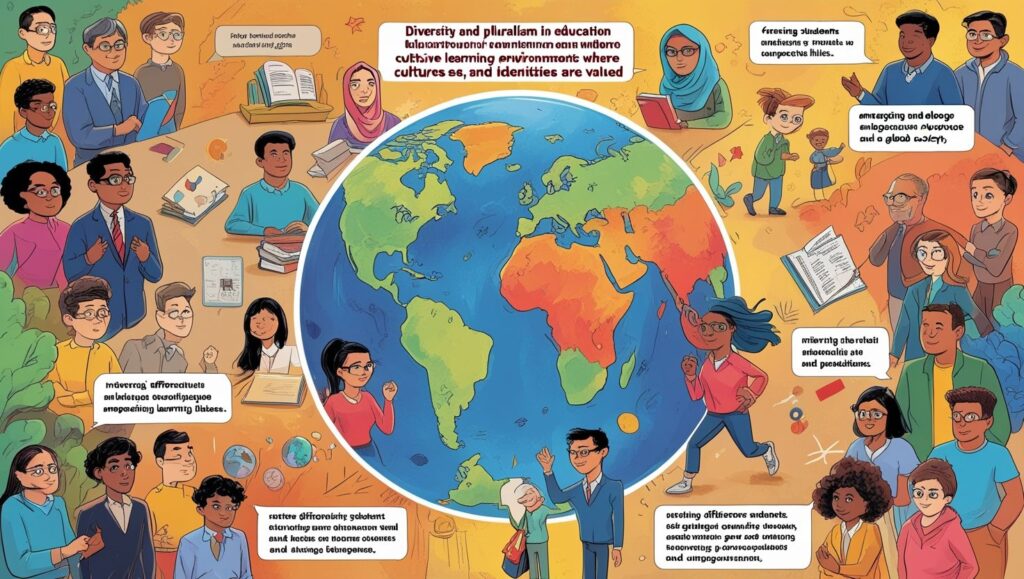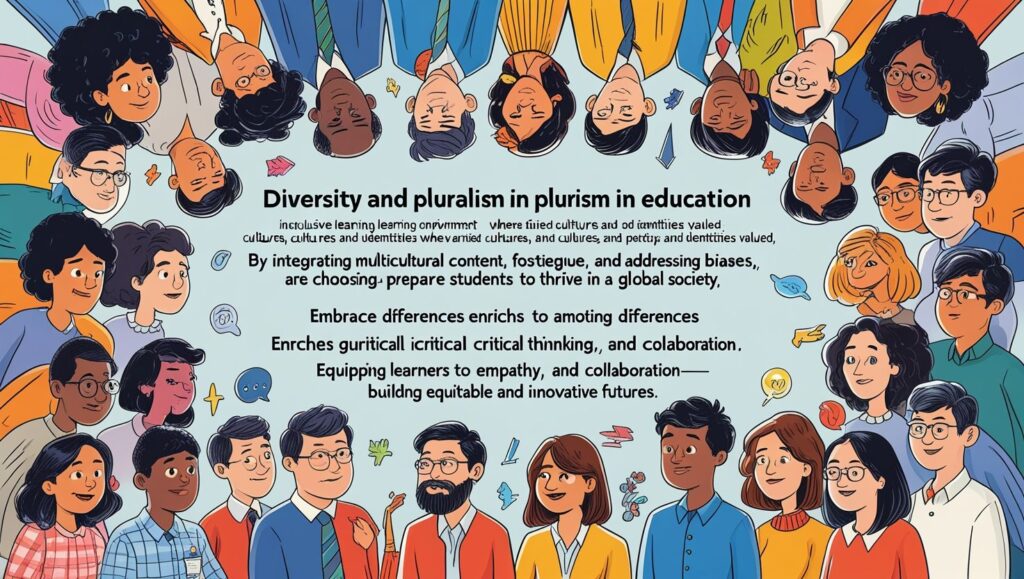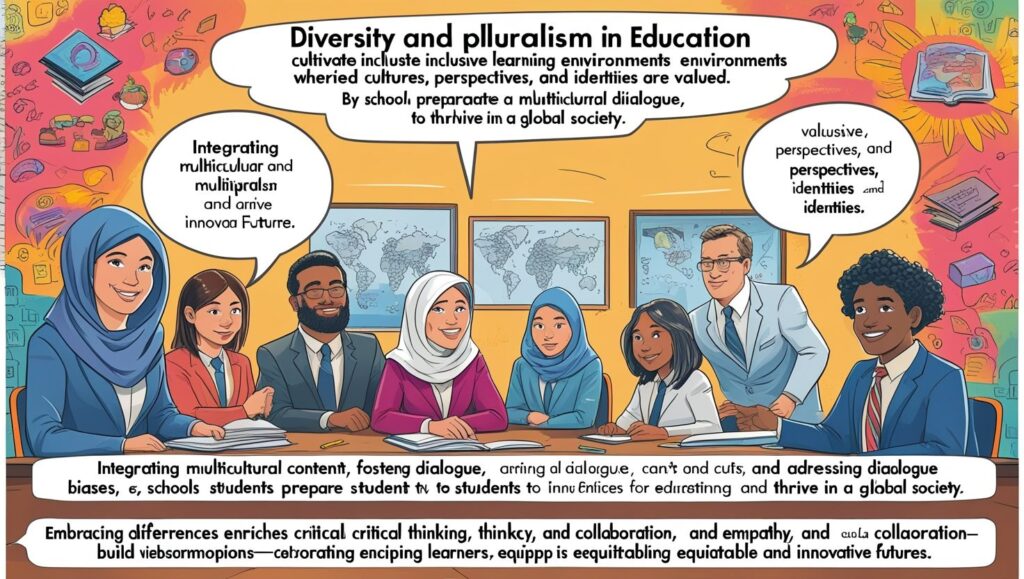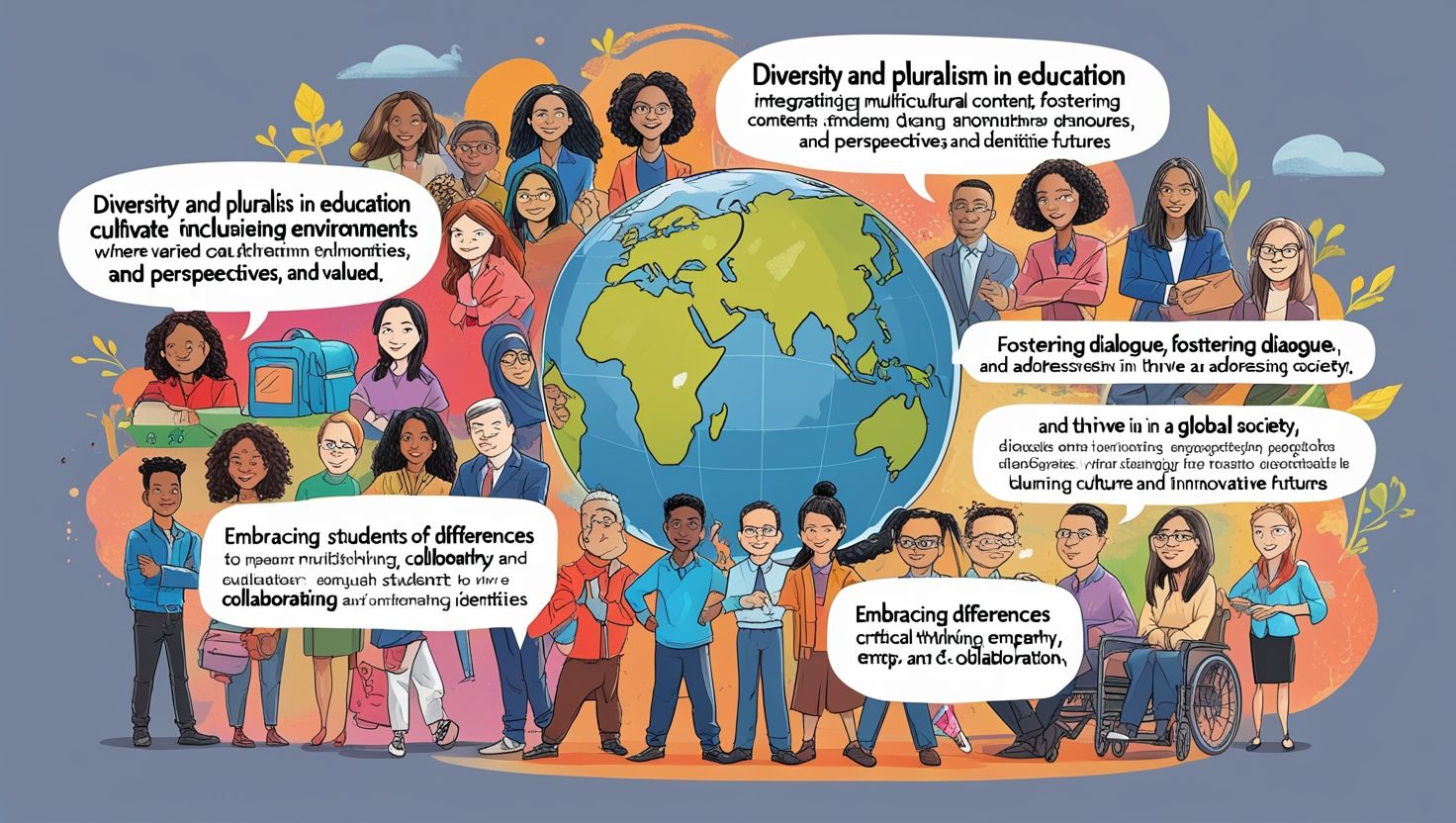1. Introduction
Diversity and Pluralism in Education, Diversity and pluralism in education represent the inclusive and multifaceted nature of learning environments that respect and value differences among individuals. Diversity encompasses variations in race, ethnicity, gender, religion, language, ability, socioeconomic status, and more. Pluralism, on the other hand, refers to the philosophical and practical acknowledgment of multiple perspectives, beliefs, and values coexisting within a society and, consequently, in its education systems.
When schools embrace these concepts, they aim to create environments that not only tolerate but also celebrate differences. This leads to enriched learning experiences, promoting understanding, acceptance, and social cohesion. Education systems must evolve to reflect the diverse societies they serve, ensuring equitable opportunities for all learners. The recognition of multiple voices and experiences fosters critical thinking, empathy, and democratic engagement. Furthermore, pluralism challenges the dominance of singular narratives and offers a more holistic approach to knowledge. Integrating these principles prepares students for global citizenship, equipping them with the skills and mindset needed to thrive in a complex, interconnected world.
2. Historical Background and Evolution
The integration of diversity and pluralism in education has roots in broader civil rights and social justice movements across the world. In the early 20th century, education systems in many countries predominantly reflected the cultural norms and values of dominant groups, marginalizing minority voices. With the rise of decolonization, civil rights struggles, and feminist movements, there was a push toward more inclusive curricula and educational reforms. In the United States, landmark cases like Brown v. Board of Education (1954) marked a turning point by challenging racial segregation in schools.
Similarly, other nations began to recognize the educational needs of indigenous peoples, immigrants, and linguistic Indigenous peoples. Over time, the concept of multicultural education emerged, promoting the inclusion of various cultural perspectives. This evolved into a broader framework encompassing diversity and pluralism, not just as add-ons but as foundational principles. Today, global migration, technological advancements, and growing awareness of equity issues continue to shape educational policies that emphasize inclusivity, representation, and social justice within classrooms and institutions.

3. Cultural Diversity in the Classroom
Cultural diversity in the classroom refers to the presence of students from varied cultural, linguistic, and ethnic backgrounds. This diversity enriches the educational experience by introducing multiple perspectives, traditions, and worldviews. For educators, this dynamic requires sensitivity and adaptability to meet the diverse needs of learners. Teachers must be culturally responsive, which involves recognizing students’ cultural identities and incorporating their backgrounds into the curriculum. This not only validates students’ experiences but also promotes engagement and academic success.
Inclusive pedagogy encourages mutual respect and fosters an environment where all students feel valued and supported. Challenges, such as language barriers and cultural misunderstandings, can arise but can be mitigated through intentional strategies like differentiated instruction, culturally relevant materials, and community involvement. Celebrating cultural festivals, incorporating multilingual resources, and facilitating cross-cultural dialogue are effective practices. Ultimately, culturally diverse classrooms prepare students for global interaction and multicultural cooperation, promoting empathy and dismantling stereotypes. Such environments are essential for fostering inclusive and equitable education for all learners.
4. Linguistic Pluralism in Education
Linguistic pluralism acknowledges the presence and legitimacy of multiple languages within an educational context. This approach values students’ native languages as assets rather than barriers, promoting bilingualism or multilingualism as key components of learning. Language plays a central role in identity formation, communication, and cognitive development. In linguistically plural classrooms, teachers integrate students’ home languages into instruction, thereby enhancing comprehension and participation.
This fosters a sense of belonging among language minority students and improves academic outcomes. Policies that support mother-tongue education in early grades, combined with systematic second-language instruction, are considered effective models. Furthermore, linguistic pluralism helps preserve endangered languages and promotes intergenerational cultural continuity. Educators must also be equipped with training and resources to teach in multilingual environments effectively. Challenges include a lack of materials in minority languages and institutional biases favoring dominant tongues. Nevertheless, embracing linguistic diversity not only empowers students but also enriches the entire classroom community. It reflects a commitment to inclusion, equity, and the global nature of communication in today’s world.

5. Religious and Ideological Inclusivity
Religious and ideological pluralism in education entails creating learning spaces that respect and accommodate diverse beliefs, faiths, and value systems. In many societies, students come from various religious backgrounds or may hold secular or philosophical worldviews. Schools must navigate this diversity by promoting mutual respect, understanding, and freedom of belief. This includes ensuring that religious practices such as prayer, dietary needs, or attire are respected. Curriculum content should avoid promoting one religion over others and instead educate about multiple faith traditions in a neutral, informative manner.
Moral education, ethics, and civic responsibility can be taught in a way that aligns with universal human values. Teachers play a crucial role in preventing religious discrimination and promoting dialogue. Inclusive practices can include celebrating various religious holidays, inviting interfaith speakers, or facilitating respectful discussions on belief systems. These efforts help students develop empathy, critical thinking, and global awareness. A pluralistic approach to religious diversity contributes to social harmony, challenges prejudice, and supports the rights of all learners.
6. Gender and Sexual Orientation in Education
Promoting gender and sexual orientation inclusivity in education is essential for fostering safe, supportive, and empowering learning environments. Traditional education systems often reinforced gender binaries and excluded non-heteronormative identities. However, as awareness of LGBTQ+ issues grows and gender diversity becomes more visible, schools must adapt to ensure all students feel recognized and respected. This includes using inclusive language, offering comprehensive sexuality education, and addressing bullying or discrimination based on gender identity or orientation.
Gender equity also involves challenging stereotypes in curriculum content and encouraging equal participation in all subjects and activities. For instance, ensuring that girls have access to STEM opportunities or that boys feel comfortable pursuing the arts can dismantle traditional gender roles. Teachers need training to handle these topics sensitively and supportively. Representation matters—students should see diverse identities reflected in literature, history, and media studies. Creating gender-inclusive policies and spaces (e.g., bathrooms, sports teams) further affirms students’ identities. Ultimately, embracing gender and sexual orientation diversity enriches education and promotes human dignity.
7. Inclusion of Students with Disabilities
Inclusive education for students with disabilities ensures that all learners, regardless of physical, cognitive, sensory, or emotional differences, have access to quality education in mainstream settings. Rather than isolating these students in special schools or classrooms, inclusive practices emphasize participation, collaboration, and support within general education environments. The principle of inclusion is grounded in the belief that diversity enriches the learning experience for everyone.
Teachers must adapt instruction through differentiated teaching, individualized education plans (IEPs), and the use of assistive technologies. Collaboration with special educators, therapists, and families is vital for addressing unique needs. Barrier-free infrastructure, accessible learning materials, and universal design for learning (UDL) are essential elements. Inclusive education fosters empathy, social interaction, and mutual understanding among students. It also aligns with international frameworks like the UN Convention on the Rights of Persons with Disabilities. While challenges such as limited resources and inadequate training exist, commitment to inclusion upholds the right to education for all and cultivates a just, equitable learning environment.
8. Socioeconomic Diversity in Learning Environments
Socioeconomic diversity in education refers to the inclusion of students from varied income levels, backgrounds, and living conditions. Children from disadvantaged backgrounds often face challenges such as limited access to resources, poor nutrition, or unstable housing, which can affect their academic performance. Inclusive education must address these disparities by providing equitable access to learning opportunities. Strategies include offering free or subsidized meals, scholarships, school supplies, and support services such as counseling and tutoring.
Schools can also implement inclusive pedagogy that values all experiences and avoids deficit thinking. Educators must be aware of implicit biases and avoid making assumptions based on students’ socioeconomic status. Building strong school-community partnerships and involving parents in the learning process can further support students. Socioeconomic diversity also benefits wealthier students by fostering empathy, reducing prejudice, and preparing them to work in diverse environments. Equitable education is not just about access, but also about success and inclusion. Ensuring that all students, regardless of their background, can thrive is a fundamental goal of education.

9. Role of Teachers and School Leadership
Teachers and school leaders are pivotal in fostering diversity and pluralism in education. Their attitudes, knowledge, and practices directly influence whether students experience an inclusive learning environment. Educators must model respect for all backgrounds, actively challenge stereotypes, and incorporate diverse perspectives into their teaching. Culturally responsive pedagogy, anti-bias training, and inclusive curriculum development are essential tools for educators. School leaders play a strategic role in creating policies that support equity, such as inclusive admissions, zero-tolerance for discrimination, and professional development on diversity issues.
They must ensure that the school climate is welcoming for all, including students, staff, and families from marginalized groups. Leaders should also prioritize hiring diverse staff and supporting minority teachers in leadership roles. Collaboration with communities, listening to student voices, and continuous assessment of inclusion efforts are key. By embodying the values of pluralism, teachers and leaders not only impact academic outcomes but also nurture socially responsible, open-minded future citizens who appreciate diversity as a strength.
10. Conclusion and Future Directions
Diversity and pluralism in education are no longer optional ideals but necessary imperatives in today’s interconnected world. As societies become increasingly multicultural, multilingual, and multifaceted, education systems must reflect and embrace this complexity. The journey toward inclusive education involves continual reflection, innovation, and advocacy. Schools must move beyond tokenism to systemic changes that promote equity at all levels—from curriculum to pedagogy, infrastructure to leadership. Embracing diversity is not merely about accommodating differences but about recognizing the value each learner brings.
Moving forward, teacher training institutions should embed inclusivity principles in their programs, while policymakers must ensure that funding, resources, and legislation support equitable practices. Technology can be harnessed to bridge gaps and amplify marginalized voices. Research into best practices should inform ongoing reforms. Ultimately, pluralism in education fosters a more just, empathetic, and democratic society. By nurturing inclusive schools today, we are shaping inclusive communities tomorrow. The future of education lies in its ability to honor and uplift the rich tapestry of humanity.
References:
- Banks, J. A. (2015). Cultural Diversity and Education: Foundations, Curriculum, and Teaching. Routledge.
- Nieto, S., & Bode, P. (2018). Affirming Diversity: The Sociopolitical Context of Multicultural Education. Pearson.
- UNESCO. (2020). Inclusion and Education: All Means All – Global Education Monitoring Report.
- Gay, G. (2010). Culturally Responsive Teaching: Theory, Research, and Practice. Teachers College Press.
- United Nations. (2006). Convention on the Rights of Persons with Disabilities.

h4t4vu
Its like you read my mind! You seem to know a lot about this, like you wrote the book in it or something. I think that you could do with some pics to drive the message home a bit, but instead of that, this is wonderful blog. A fantastic read. I will certainly be back.
g1bqbo
Adorei este site. Pra saber mais detalhes acesse o site e descubra mais. Todas as informações contidas são conteúdos relevantes e únicos. Tudo que você precisa saber está está lá.
I don’t even know how I ended up here, but I thought this post was good. I don’t know who you are but definitely you’re going to a famous blogger if you aren’t already 😉 Cheers!
Hi, Neat post. There is a problem with your web site in internet explorer, would test this… IE still is the market leader and a large portion of people will miss your wonderful writing because of this problem.
I am delighted that I found this website, exactly the right information that I was looking for! .
Really wonderful info can be found on site. “Many complain of their memory, few of their judgment.” by Benjamin Franklin.
I have been exploring for a little bit for any high-quality articles or weblog posts in this kind of house . Exploring in Yahoo I ultimately stumbled upon this website. Reading this info So i?¦m happy to show that I’ve a very excellent uncanny feeling I found out exactly what I needed. I most indubitably will make certain to do not omit this web site and give it a look regularly.
You completed a number of fine points there. I did a search on the subject matter and found a good number of persons will have the same opinion with your blog.
Oh my goodness! an incredible article dude. Thank you Nonetheless I’m experiencing problem with ur rss . Don’t know why Unable to subscribe to it. Is there anyone getting identical rss problem? Anybody who is aware of kindly respond. Thnkx
I will right away grasp your rss as I can not in finding your e-mail subscription hyperlink or newsletter service. Do you’ve any? Kindly let me recognize in order that I could subscribe. Thanks.
Its superb as your other blog posts : D, appreciate it for putting up. “The real hero is always a hero by mistake he dreams of being an honest coward like everybody else.” by Umberto Eco.
Some genuinely nice and useful information on this website, also I believe the design holds fantastic features.
obviously like your web site however you need to take a look at the spelling on several of your posts. A number of them are rife with spelling issues and I in finding it very troublesome to tell the reality nevertheless I will definitely come again again.
I have recently started a web site, the info you offer on this web site has helped me tremendously. Thank you for all of your time & work.